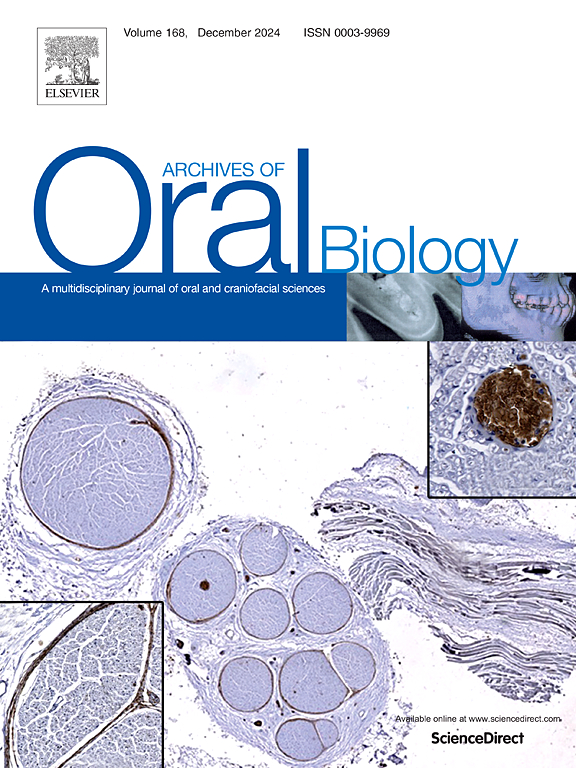Expression patterns of desmosome family members during tooth development and the role of Desmocollin-3 in cytodifferentiation of stratum intermedium
IF 2.1
4区 医学
Q2 DENTISTRY, ORAL SURGERY & MEDICINE
引用次数: 0
Abstract
Objective
Desmocollin-3 (Dsc3), a desmosomal cadherin, is critical in maintaining epithelial cohesion and integrity. Despite its recognized function in skin and mucosal epithelium, its contribution to tooth development remains poorly understood. The study aims to identify stratum intermedium (SI)-specific markers using single-cell RNA-sequence (scRNA-seq) and to investigate the functional role of Dsc3 in maintaining SI cell integrity and differentiation.
Design
In this study, we pursued the marker genes of SI cells using scRNA-seq analysis of post-natal day 12 molar. Furthermore, we examined the role of the SI marker gene using dental epithelial cell line SF2.
Results
We found that desmosome family genes are highly expressed in SI cluster and among them, Dsc3 showed specific expression in SI cluster. Knockdown of Dsc3 in the SF2 epithelial cell line led to significantly smaller cell size, indicating impaired epithelial differentiation. The expression of SI marker genes was suppressed by the knockdown of Dsc3 with a marked loss of tight junction protein Tjp1 (ZO-1), indicating disrupted intercellular junctions and impaired epithelial barrier function. This disruption correlated with altered expression of key ameloblast differentiation markers, suggesting a failure in proper ameloblast lineage commitment, highlighting a disruption in the SI’s ability to support ameloblast lineage specification.
Conclusion
These findings indicate that Dsc3 is essential for SI structural integrity and its signaling support to ameloblasts.
牙齿发育过程中桥粒家族成员的表达模式及桥粒蛋白-3在中间层细胞分化中的作用。
目的:桥粒蛋白-3 (desmocolin -3, Dsc3)是一种桥粒体钙粘蛋白,对维持上皮内聚和完整性至关重要。尽管它在皮肤和粘膜上皮中具有公认的功能,但它对牙齿发育的贡献仍然知之甚少。本研究旨在利用单细胞rna序列(scRNA-seq)鉴定地层间质(SI)特异性标记,并研究Dsc3在维持SI细胞完整性和分化中的功能作用。设计:在本研究中,我们使用scRNA-seq分析出生后12天臼齿的SI细胞的标记基因。此外,我们用牙上皮细胞系SF2检测了SI标记基因的作用。结果:我们发现桥粒家族基因在SI簇中高表达,其中Dsc3在SI簇中特异性表达。在SF2上皮细胞系中敲低Dsc3导致细胞大小明显变小,表明上皮分化受损。SI标记基因的表达被Dsc3的敲低所抑制,紧密连接蛋白Tjp1 (ZO-1)的显著缺失,表明细胞间连接被破坏,上皮屏障功能受损。这种破坏与关键成釉细胞分化标志物的表达改变有关,表明成釉细胞谱系的正常承诺失败,突出了SI支持成釉细胞谱系规范的能力的破坏。结论:这些发现表明Dsc3对SI结构完整性及其对成釉细胞的信号支持至关重要。
本文章由计算机程序翻译,如有差异,请以英文原文为准。
求助全文
约1分钟内获得全文
求助全文
来源期刊

Archives of oral biology
医学-牙科与口腔外科
CiteScore
5.10
自引率
3.30%
发文量
177
审稿时长
26 days
期刊介绍:
Archives of Oral Biology is an international journal which aims to publish papers of the highest scientific quality in the oral and craniofacial sciences. The journal is particularly interested in research which advances knowledge in the mechanisms of craniofacial development and disease, including:
Cell and molecular biology
Molecular genetics
Immunology
Pathogenesis
Cellular microbiology
Embryology
Syndromology
Forensic dentistry
 求助内容:
求助内容: 应助结果提醒方式:
应助结果提醒方式:


